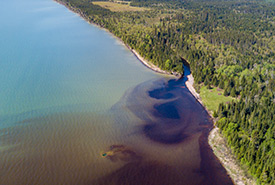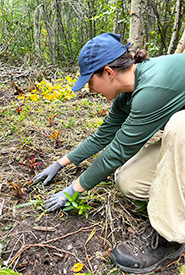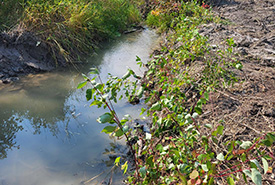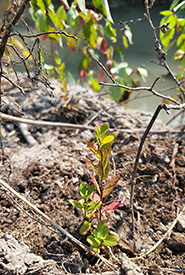NCC: Land Lines – Restoring Waterways at Black Bay

Black Bay, Lake Superior, ON (Photo by Costal Productions)
Growing up in Ontario, I have seen many diverse natural areas, but the North Shore of Lake Superior boasts the most beautiful landscapes and habitats I have ever experienced. And I am grateful to have helped protect and rehabilitate some of these beautiful places in the summer of 2024 as the Nature Conservancy of Canada’s (NCC’s) Conservation Intern for Northwestern Ontario.
Lake Superior is an astounding demonstration of Mother Nature’s selection of only the most resilient of species, thriving in nutrient-poor and frigid waters. Despite these harsh conditions, nestled in the northwest corner of Lake Superior are the shallow, sheltered and marsh-covered shorelines of Black Bay, which foster a safe space for many aquatic- and shoreline-dependant species to rest, hide, play and thrive.

Hannah adding natural materials around new plants (Photo by NCC)
While working with NCC this year, I helped steward the Black Bay Peninsula, one of NCC’s focal areas in the Lake Superior Natural Area. Paddling along the northern shoreline of Black Bay, I discovered that the sandy, silty lake bottom was covered in moose and great blue heron tracks. Carefully keeping my paddle from scraping the bottom of the 10-centimetre-deep water, I noticed the diverse texture of waterweeds, water-milfoils and tangled eelgrasses happily animating the warm, shallow shorelines, and invariably winding around my paddle. The moose tracks skirted the patches of cattails where large chunks of the stalk had been chewed like a celery stick. I imagined the moose wading past and acknowledging the carefully balanced great blue herons patiently awaiting a flush of minnows.
Relatively warm, shallow water species, such as perch, walleye and bass, are some of the year-round residents of Black Bay. White sucker, brook trout, rainbow trout and lake sturgeon (a species at risk) also reside here but rely on access to creeks, streams and rivers for spawning and migration routes. It is important that these waterways remain unobstructed so these species can move freely within and between spawning areas and the rest of Lake Superior.

Cold Creek after planting (Photo by NCC)
Cold Creek is a tributary flowing into Black Bay, running through lands cared for by NCC. There is a section of Cold Creek that, until recently, was blocked by old, dislodged culverts placed there years before NCC purchased the land. This summer, we worked with contractors to completely remove the old culverts, allowing fish to move between the waterway and Lake Superior. In summer 2024, thanks to the support of the Ontario Wildlife Foundation, we were able to work with contractors to completely remove the old culverts, allowing fish to move between the waterway and Lake Superior.
Our Black Bay restoration project also involved removing dilapidated buildings and garbage. Leaving waste, such as old cars, could result in chemicals leaching into the surrounding soils, groundwater and ultimately into Cold Creek. Removing debris like sharp metal objects helps prevent potential injuries to birds, such as crows and ravens. As corvid species, like these birds, are attracted to shiny metal objects, they could be injured while picking up sharp or contaminated objects.

New planting alongside Cold Creek (Photo by NCC)
After the culverts and buildings were removed, the stewardship team hiked down to the river, collecting small stakes of dogwood and willow along the way to use to help restore the bank. We bolstered the existing bank biodiversity by planting site-appropriate, locally sourced native plants, including Bebb’s sedge, fox sedge and Crawford’s sedge. These plants will help prevent creek bank erosion and allow the site’s biodiversity to recover more quickly. At the site of the building removal, we planted native species that like well-drained soil, such as early goldenrod, meadowsweet and milkweed among others, in the newly opened clearings to create pollinator habitat.
The principles that many outdoor and nature enthusiasts live by fall under a general rule of thumb: leave no trace. This also includes leaving a space better than when we found it. Just like removing culverts and old buildings and garbage to help restore a natural area, having a bag in your pocket on your next hike to pick up stray garbage is a step toward maintaining healthy ecosystems.
Being part of this project has given me a learning experience that I’ll be able to carry with me as I continue my journey in conservation, and even more importantly, a pool of knowledge that I can share with others and the future generation of stewards.




